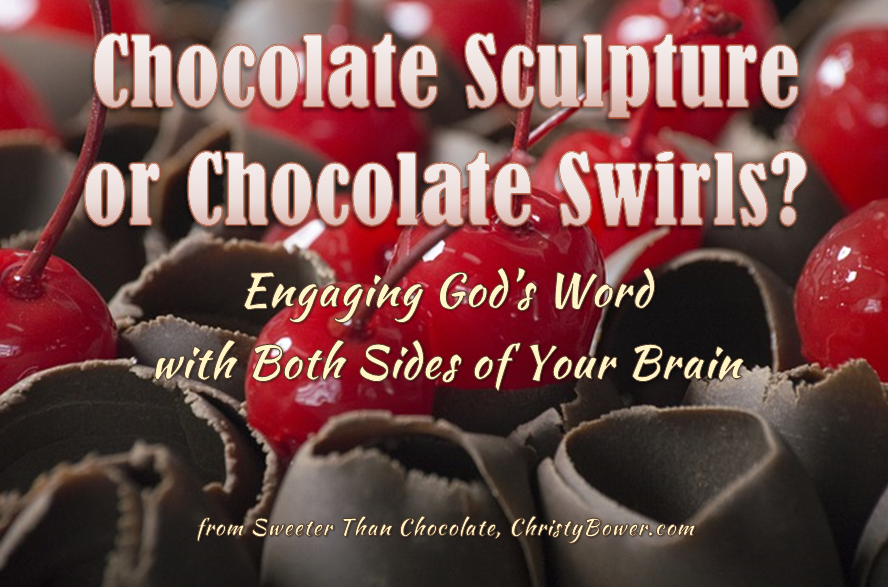Some people might study a chocolate sculpture to examine every detail with precision. How did the sculptor make each cut or create different textures? What holds it up? Is it one piece or sections bound together? What makes the eyes look so real?
On the other hand, some people aren’t interested in the details; they just want to appreciate the chocolate decorations, big or small, for their artistic impression and the mood they create. In a sense, they want to meditate on the chocolate art rather than study it.
What’s the difference between studying the Bible and meditating on it?
Study is a linear approach to the Bible that follows steps and organizes the material to make sense of it. It is necessary for us to dig deep to understand what the Bible teaches, but it is a very left-brain process.
- The left-brain is the logical, linear, fact-storing part of the brain.
- The right brain is the abstract, creative, holistic part of the brain.
Most of us have a tendency toward one or the other. Which way do you lean? If you’re a left-brained person, then study is a natural realm for you, but if you’re more of a right-brained person, you may find study difficult, cumbersome, and boring.
Right brain folks would rather look at the big picture of Scripture than dig up details. That’s okay. They want to express themselves. They doodle. They dabble. They see the world in pictures rather than linear structures.
Although the left and right sides of the brain serve different functions, they both want to have a part in the process. Unfortunately, most of us learn to study the Bible and that’s it. The right brain never gets involved, which is why we may tend to find studying the Bible (or anything else) boring.
You see, we have to engage God’s Word with both sides of the brain. Yes, we need the left-brain to study, organize, and analyze the Bible. That’s how we learn the substance of God’s Word. However, we also need to engage the right brain to meditate on God’s Word.
When I talk about meditating on the Bible, I’m simply encouraging you to engage the right brain to help finish processing what you’ve learned.
Christian meditation is not weird, creepy spiritual exercises designed to empty our minds. Christian meditation is simply allowing our minds some breathing space to take the things we learned with the left brain and let them have time to dance and play in our head and heart. It allows the right brain to turn the truth over in our minds, looking at it from different angles.
The problem is we’re too busy and we often lack the focus to let our minds dwell on a passage of Scripture for very long. Most of us think of meditation as a static activity in which we stare at a passage of the Bible and think about it. For me, meditating on God’s Word is a way to enjoy it and engage with it in a personal and casual way.
We need to approach Scripture with both sides of our brain. Left brainers tend to do all the left-brain work of study and when we’re done analyzing, we think we’ve mastered it. But to truly experience the Bible, we need to engage the right side of the brain to make it personal and bring us closer to living it out. Right brainers might tend to skip the study and get lost in an abstract world of finding meaning and significance in the Scripture.
- Study without meditation tends to produce lifeless knowledge.
- Meditation without study tends to produce emotional whims.
Study followed by meditation produces a depth of insight that makes the Bible come alive, making us a part of it as we experience it in our hearts, and making it a part of us as we live it out. Both study and meditation are valuable and necessary.
We study the Bible to understand it, but we meditate on the Bible to make it personal.
Applying the Bible to our lives is one of the steps of studying the Bible, but that can be a mere cognitive awareness of what we should do.
I’m talking about getting the Bible to go deep and take root so that doing isn’t just a single, conscious act of obedience, but a natural, inherent part of your being that continuously, unconsciously lives the truth for the rest of your life. Do you see the difference?
We cannot come to the Bible to identify propositions and principles for us to obey religiously. That perception holds the principles as something external to us. We identify them, study them, admire them, and obey them, but they are an external truth.
The process of meditation engages the truth in a different way. When the imagination gets involved, it processes the information holistically so the emotions get involved. The process engages both mind and heart.
I’m not talking about seeking an emotional experience or letting our emotions run away, but when we experience the Bible, it affects all of who we are. We are digesting the Word so it becomes a part of us.

This is an excerpt from Sweeter Than Chocolate: Developing a Healthy Addiction to God’s Word. Used by permission.







